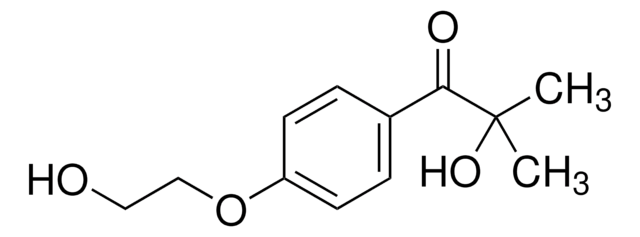Kluczowe dokumenty
729094
Poly(ethylene glycol) diacrylate
average Mn 10,000, acrylate, MEHQ as inhibitor (may contain)
Synonim(y):
Polyethylene glycol, PEG diacrylate
About This Item
Polecane produkty
Nazwa produktu
Poly(ethylene glycol) diacrylate, average Mn 10,000, contains MEHQ as inhibitor
Formularz
solid
Poziom jakości
masa cząsteczkowa
average Mn 10,000
zawiera
MEHQ as inhibitor
≤1,500 ppm MEHQ as inhibitor (may contain)
przydatność reakcji
reagent type: cross-linking reagent
reaction type: Polymerization Reactions
temp. przejścia
Tm 60-64 °C
Mw/Mn
<1.1
Ω-koniec
acrylate
α-koniec
acrylate
architektura polimerowa
shape: linear
functionality: homobifunctional
temp. przechowywania
−20°C
ciąg SMILES
OCCO.OC(=O)C=C
InChI
1S/C8H10O4/c1-3-7(9)11-5-6-12-8(10)4-2/h3-4H,1-2,5-6H2
Klucz InChI
KUDUQBURMYMBIJ-UHFFFAOYSA-N
Szukasz podobnych produktów? Odwiedź Przewodnik dotyczący porównywania produktów
Powiązane kategorie
Zastosowanie
- 3D Bioprinting of Hydrogels: This study explores the formulation of PEGDA-based hydrogels for 3D bioprinting, focusing on rheological properties and structural fidelity, particularly relevant for tissue engineering applications (Wu et al., 2018).
- Sustained Ocular Drug Delivery: Investigates the delivery of small and large drug molecules using PEGDA implants, highlighting the implications for sustained drug release in ocular therapies (McAvoy et al., 2018).
- Tissue Engineering Scaffolds: Evaluates PEGDA-polycaprolactone scaffolds for tissue engineering, emphasizing the control over porosity and its importance for regenerative medicine applications (Kotturi et al., 2017).
- Photocrosslinked Hydrogel Implants: Focuses on photocrosslinked PEGDA implants for drug delivery, providing insights into the design of drug delivery systems that can be finely tuned for specific therapeutic needs (Qin et al., 2015).
- Hydrogel-Based Artificial Muscles: Characterizes PEGDA/acrylic acid hydrogels optimized for use as artificial muscles, highlighting their potential in biomedical engineering and smart materials (Browe et al., 2017).
Uwaga dotycząca przygotowania
Hasło ostrzegawcze
Danger
Zwroty wskazujące rodzaj zagrożenia
Zwroty wskazujące środki ostrożności
Klasyfikacja zagrożeń
Eye Dam. 1 - Skin Irrit. 2 - Skin Sens. 1
Kod klasy składowania
11 - Combustible Solids
Klasa zagrożenia wodnego (WGK)
WGK 1
Temperatura zapłonu (°F)
Not applicable
Temperatura zapłonu (°C)
Not applicable
Wybierz jedną z najnowszych wersji:
Masz już ten produkt?
Dokumenty związane z niedawno zakupionymi produktami zostały zamieszczone w Bibliotece dokumentów.
Klienci oglądali również te produkty
Produkty
W ciągu ostatnich dwóch dekad inżynieria tkankowa i medycyna regeneracyjna stały się ważnymi dziedzinami interdyscyplinarnymi, które obejmują biologię, chemię, inżynierię i medycynę.
In the past two decades, tissue engineering and regenerative medicine have become important interdisciplinary fields that span biology, chemistry, engineering, and medicine.
Devising biomaterial scaffolds that are capable of recapitulating critical aspects of the complex extracellular nature of living tissues in a threedimensional (3D) fashion is a challenging requirement in the field of tissue engineering and regenerative medicine.
Nasz zespół naukowców ma doświadczenie we wszystkich obszarach badań, w tym w naukach przyrodniczych, materiałoznawstwie, syntezie chemicznej, chromatografii, analityce i wielu innych dziedzinach.
Skontaktuj się z zespołem ds. pomocy technicznej









